Discover JNOD Electric Boiler System: Types, Models & Features...(Complete Guide)
Table of Contents
Are you thinking about replacing your old boiler with an electric one? In the growing field of HVAC, electric boilers are becoming popular heating products due to their high efficiency, energy efficiency, eco-friendliness and multi-function. Electric heating is the future, and many householders are considering electric heating products.
In this comprehensive guide, our ultimate goal is to give our customers a deeper understanding of JNOD electric boilers. Providing you with the product-related knowledge you need, so you can make a wise decision when choosing an electric boiler for your home heating needs, ensuring that you invest in a solution that offers the highest levels of efficiency, reliability and comfort.
Understand JNOD Electric Boiler System: An In-Depth Look at Their Types, Models, and Characteristics
Open Vented Type
The open-vented electric boiler requires the connection of a separate circulation pump, expansion tank and water tank. It is usually used in homes with space for an external water tank. This type of boiler is ideal for homes with multiple bathrooms that can also be heated.
Below are the sizes and voltages corresponding to the different models.
BQ: 5.5/7.5/9.5/11/13/14.4kW@230v/400v, 16/20kW@400V
BC: 5.5/7.5/9.5/11/13/14.4kW@230v/400v, 16/20/23/26kW@400V
BK: 40/52kW@400V
BE: 7/10/12/14/18/21/25/27kW@240V
It will have a smaller exterior size than other electric boiler types, which is more space-saving. The BQ has the smallest exterior size, the BC has 23/26kw size options, and the BK has the largest size.
Electric System Boiler
The system electric boiler has a built-in circulation pump and expansion vessel. Remarkably it has only one heating element. It is designed to be used in connection with a separate water tank, thus allowing it to provide central heating and a large hot water supply.
Below are the sizes and voltages corresponding to the different models.
BO/BF/BM/BW/BT/BE-S/BX:
5.5/7.5/9.5/11/13/14.4KW@230v/400v, 16/20/23/26KW@400V
Their difference:
BO/BF: same internal structure, different displays
BM/BW/BT/BE-S: same internal structure, different panels
BO/BF VS BW/BM/BT/BE-S: different expansion tanks, different displays
BX: glass exterior, touch display, different internal structure and display compared to above
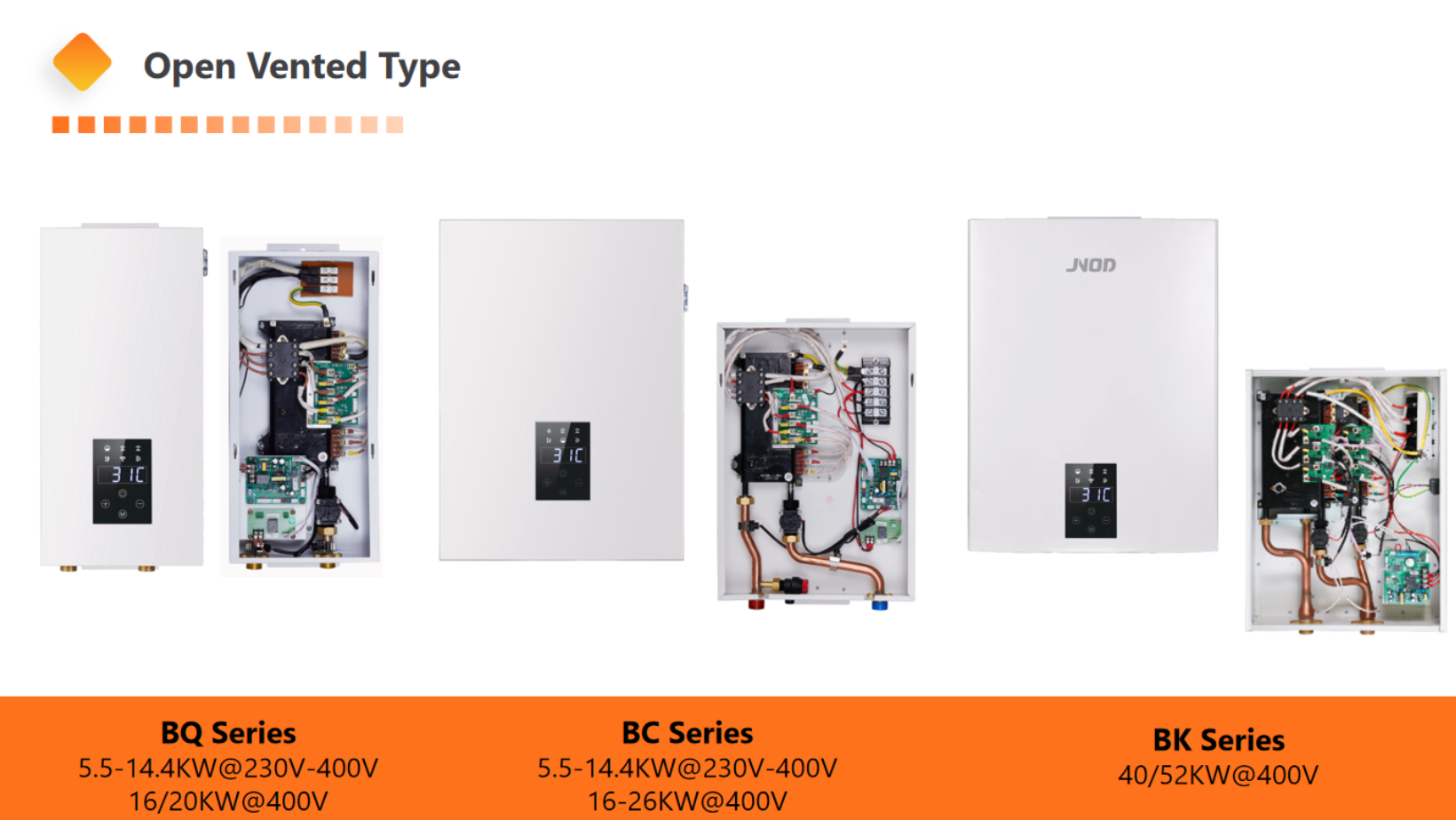


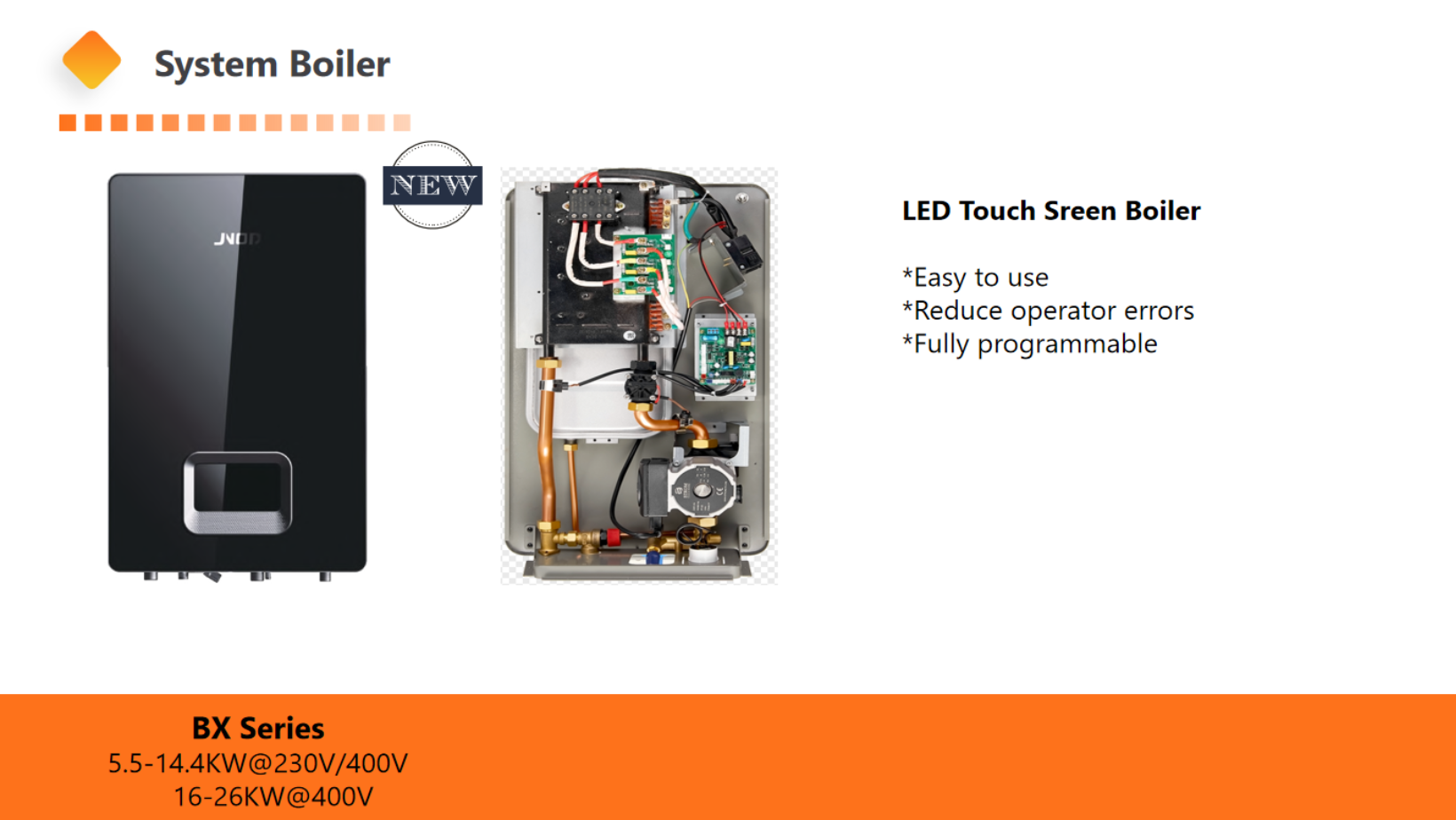
Electric Combi Boiler
The electric combi boiler has a built-in circulation pump and expansion vessel like the system electric boiler. However, it has two heating elements and is more efficient. The two heating systems can run separately or at the same time. If you need a built-in water tank, there is also a model. Models that don’t need to be connected to a tank provide hot water on demand, instantly heated and flowing.
Below are the sizes and voltages corresponding to the different models.
BO-E/BF-E/BM-E/BW-E/BT-E/BP-E:
5.5/7.5/9.5/11/13/14.4KW@230v/400v, 16/20/23/26KW@400V
BE-E: 13/14.4KW@230v/400v, 16/20/23/26KW@400V
Electric combination boilers have almost the same exterior design as system electric boilers but have two heating elements inside, one on the side. BP-E is the model with a built-in 35L water tank.
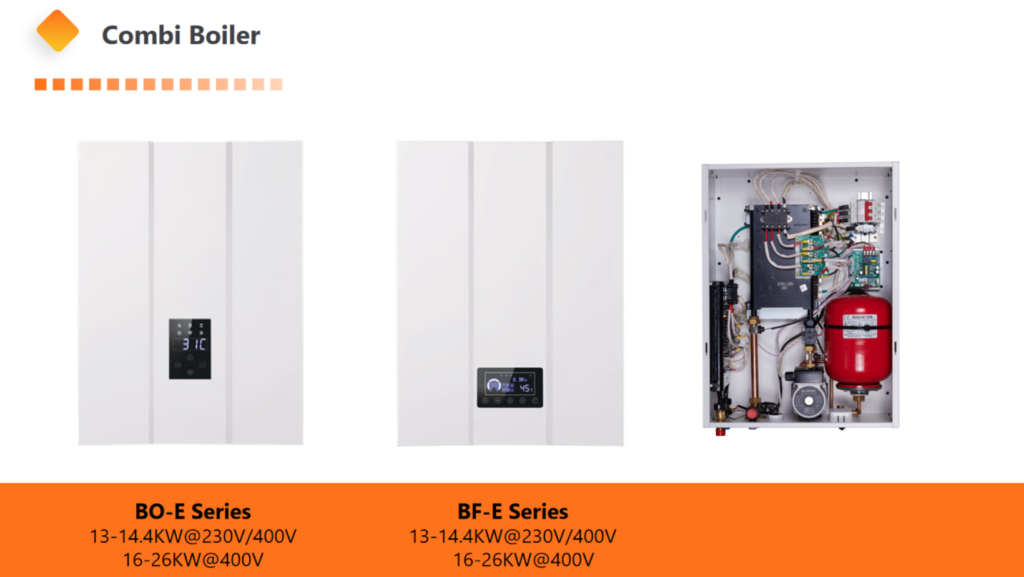
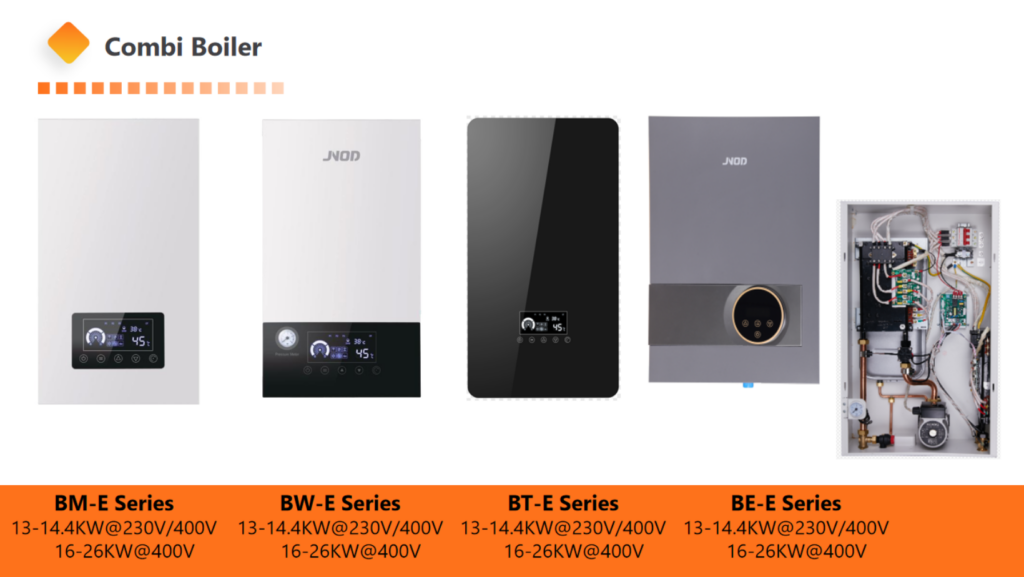
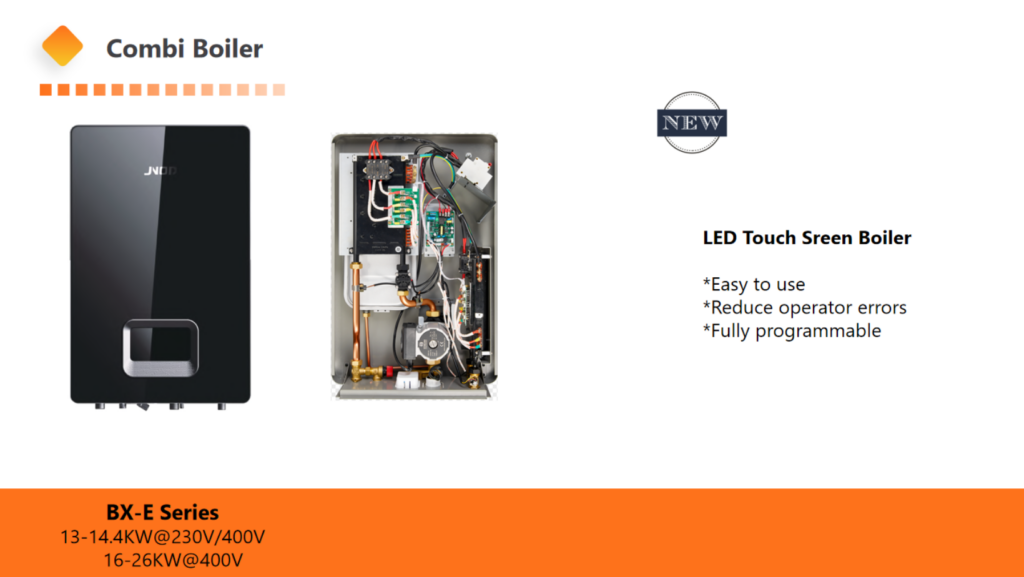
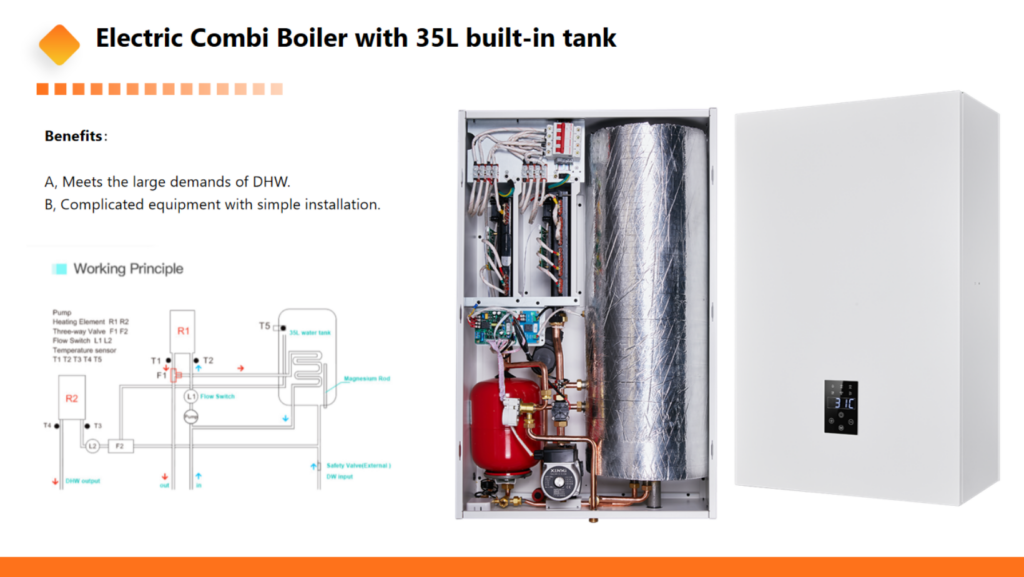
Commercial Electric Boiler
Floor-standing electric heating boilers consist of several heating elements and are designed for large public places, such as schools, hotels, hospitals, and commercial premises.
Below are the sizes and voltages corresponding to the different models:
BG: 352/378KW@400V
BL: 158/220/315KW@400V
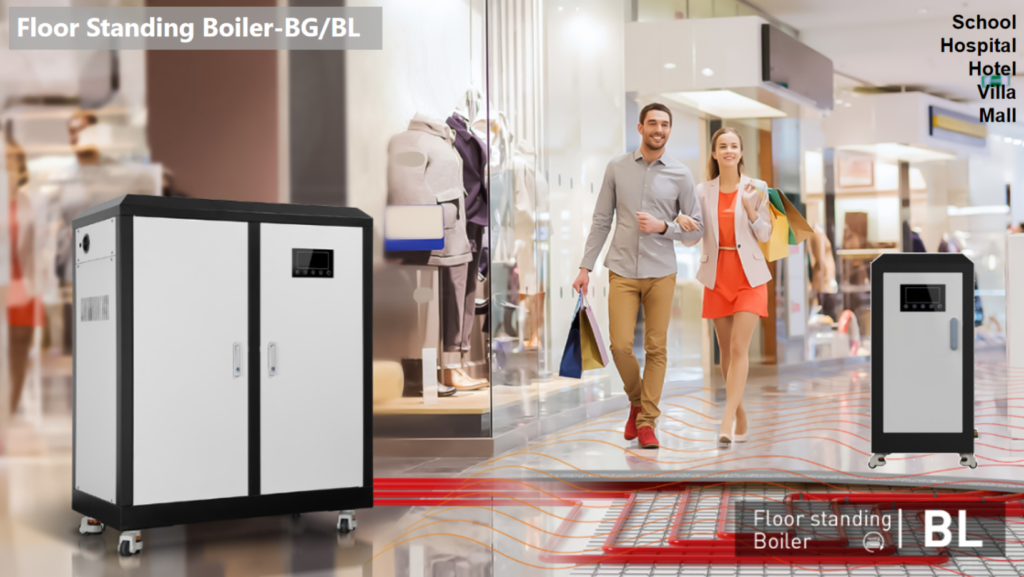
Understand JNOD Patented Heating Element: The Key to Efficiency
It is the first cast aluminum heating element technology to apply for a patent in China since 2009.
- With water and electricity separation technology, it won’t cause leakage.
- Water and corrosion resistance, no limescale for 5-8 years.
- It has a low surface heat load
- Heating efficiency is high with over 97% efficiency.
- The hot water is fully heated because it has at least 3 meters long stainless steel sink.
- It is a cast piece of the entire heating element, so it is also leak-proof.
- Cast aluminum heating element is the best choice for resisting hard water quality
- Over 8 years of life span
Understand JNOD electric boilers: Summarize their functions and features
- Double dry-heating protection function
- Automatic anti-freezing function
- High-temperature safety cut-out
- WiFl control by connecting with the room thermostat or APP (TUYA)
- Built-in fault-finding diagnostics for quick troubleshooting
- Baby lock on key
- Anti Legionella Function
- LED Touch Screen or Touch Key Screen
- 97% energy efficiency for cost savings
- Durable aluminum heat exchanger and heating elements
- Soft start feature to prevent power surges
- Integrated control panel for ease of use
- A high-pressure diversion pipe eliminates water resistance and increases the flow
- Noble exquisite inlet and outlet copper pipe design
Applied to open-vented & system boiler types:
Connect to the external water tank to provide domestic hot water. This is achieved by connecting three accessories 1. DHW External Tank Plate (detects the tank temperature and transmits a signal to the main board) 2. Tank Temperature Probe: detects the tank temperature 3. 3-Way Valve: regulates the water flow direction.
Outdoor Temperature Probe: Sensing the outdoor temperature to adjust the indoor temperature by connecting the outdoor sensor.

How to choose the right size electric boiler for your house?
In terms of heating, 1KW=10m2. For example, if the user’s home is 90m2, we can recommend 9KW.
Specifically, it also depends on the regional climate, in hot summer and cold winter countries and regions, the heating heat load is 40-60W/m2, and 100m2 of the house needs a 6kW electric boiler. In colder areas, the heating heat load is 60-120W/m2, and a 100m2 house needs a 10kW electric boiler. In extremely cold areas, the heating load is 100-160W/m2, and a 100m2 house requires a 15kW electric boiler.
In terms of providing hot water, you need to consider the number of people living in the house, the amount of hot water and the time it is used. You can also consider the number of appliances that use hot water, such as washing machines, dishwashers and showers, and how long they are typically used.
Conclusion
We offer different types of electric boilers. Domestic electric boilers are wall-mounted and have a compact design. They are available in open-vented type, system electric boilers and electric combination boilers, with sizes ranging from 5.5kw to 26kw, to meet the heating and hot water needs of different families. Commercial electric boilers are floor-standing types, which can meet the heating and hot water demand of public places.
The key component of an electric boiler is the heating element. Our patented heating elements are more than 97% efficient and the life is longer than 8 years. We got 0 complaints on this part since we adopted this technology and got great feedback from customers. The JNOD electric boiler offers a wide range of features and benefits to meet the various functional needs of our customers.
Contact us and we’ll help you choose the right model and size to keep you feeling unbelievably cozy in the winter, get endless hot water, and save money on your energy bills.
